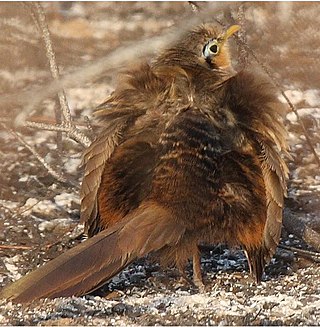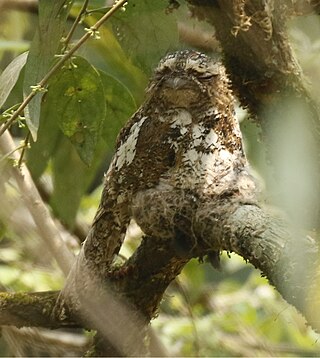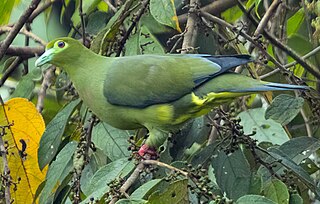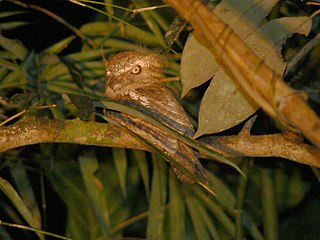
The Sri Lanka frogmouth, Sri Lankan frogmouth or Ceylon frogmouth is a small frogmouth found in the Western Ghats of south India and Sri Lanka. Related to the nightjars, it is nocturnal and is found in forest habitats. The plumage coloration resembles that of dried leaves and the bird roosts quietly on branches, making it difficult to see. Each has a favourite roost that it uses regularly unless disturbed. It has a distinctive call that is usually heard at dawn and dusk. The sexes differ slightly in plumage.

Batrachostomus is a genus of frogmouths. The generic name is a direct translation from the Greek for 'frogmouth'; batracho-/βατραχο- 'frog' and stoma-/στομα 'mouth'. It includes the following species:

The Philippine frogmouth is a nocturnal bird that can be found throughout the Philippine archipelago. It is common in lowland forests and maturing second growth. There is little information about the bird. It feeds on grasshoppers, cicadas, crickets and beetles.

The tawny-faced quail is a species of bird in the family Odontophoridae, the New World quail. It is found in Colombia, Costa Rica, Ecuador, Honduras, Nicaragua, and Panama.

The tropical boubou or bell shrike is a medium-sized passerine bird of sub-Saharan Africa. This very diverse "species" with its numerous subspecies and morphs has since long posed a taxonomic problem, and recent research suggests it is a cryptic species complex that has now been split into several species.

The band-winged nightjar or greater band-winged nightjar is a species of nightjar in the family Caprimulgidae. It is widespread in South America, where it is found in the Andes, Venezuelan Coastal Range, Santa Marta Mountains, Tepuis, most of Chile, Argentina, Paraguay, Uruguay, and eastern Brazil. It occurs in a wide range of habitats, from the edge of humid montane forests to shrubby semi-deserts and urban rooftops.

The lesser ground cuckoo is a species of cuckoo in the tribe Neomorphini of subfamily Crotophaginae. It is found in Costa Rica, El Salvador, Guatemala, Honduras, Mexico, and Nicaragua.

Blyth's frogmouth is a species of bird in the family Podargidae. It was previously considered to be conspecific with the Javan frogmouth and Palawan frogmouth. The bird is a tropical species that ranges from India to Australia.

The large frogmouth is a species of bird in the family Podargidae. It is found in Brunei, Indonesia, Malaysia, and Thailand, in subtropical or tropical moist lowland forest. Logging of its habitat poses a risk to its survival, and the International Union for Conservation of Nature has listed it as a vulnerable species.

The Sunda frogmouth is a species of bird, typically placed in the family Podargidae.

The Dulit frogmouth is a little-known species of bird in the frogmouth family, Podargidae, with a patchily recorded distribution in the mountain forests of northern and central Borneo to which it is endemic. The species is monotypic.

Hodgson's frogmouth is a species of bird in the family Podargidae. It is found in Bangladesh, Bhutan, China, India, Laos, Myanmar, Thailand, and Vietnam. Its natural habitat is temperate forests.

The Javan frogmouth, sometimes known as Horsfield's frogmouth, is a species of bird in the family Podargidae. It is sometimes considered conspecific with the Blyth's and Palawan frogmouths. Found in Southeast Asia, Indonesia and the Philippines, it lives in subtropical or tropical moist lowland forest.
The Bornean frogmouth is bird species in the family Podargidae. Some taxonomists consider it to be a subspecies of the short-tailed frogmouth, but others consider it to be a distinct species. It is found in Indonesia and Malaysia and is endemic to the island of Borneo. Its natural habitats are subtropical or tropical moist lowland forest and subtropical or tropical moist montane forest. It is threatened by habitat loss.

Gould's frogmouth is a nocturnal species of bird in the order Caprimulgiformes and the family Podargidae. It is one of the 12 species in the Batrachostomus genus. Its common name commemorates the English ornithologist and bird artist John Gould (1804-1881).

The marbled frogmouth is a bird in the family Podargidae. The species was first described by Jean René Constant Quoy and Joseph Paul Gaimard in 1830. It is found in the Aru Islands, New Guinea and Queensland. Its natural habitats are subtropical or tropical moist lowland forest and subtropical or tropical moist montane forest.

The Sumatran green pigeon is a species of bird in the pigeon family, Columbidae. First described by the Dutch zoologist Coenraad Jacob Temminck in 1823, it is endemic to Indonesia, where it is found in Sumatra and western Java. It inhabits the canopy of dense hill and montane forest and has been recorded at elevations of 350 to 1,800 m on Sumatra and 600 to 3,000 m on Java. The Sumatran green pigeon is a relatively slender species with a long wedge-shaped tail and an adult length of 29.0–34.1 cm (11.4–13.4 in) in males and 27.7–29.0 cm (10.9–11.4 in) in females. Adult males have a dark green head and body, bright yellow lower belly and undertail-coverts, dark grey tail, and bluish-green unfeathered patches on the face. Adult females are duller and have no grey on the back of the neck, a fainter orange wash on the breast, and no orange markings on the crown or the bend of the wing.

The eared pitta is a species of bird in the pitta family, Pittidae, and is found in Southeast Asia.

The Nicaraguan grackle is a species of passerine bird belonging to the genus Quiscalus, a genus of grackles in the New World blackbird family, Icteridae. It is found only in Nicaragua and northernmost Costa Rica.

The Palawan frogmouth is a species of bird in the family Podargidae. It is found on Palawan in the Philippines. Its natural habitat is tropical moist lowland forest. It is sometimes considered conspecific with the Javan and Blyth's frogmouth.




















